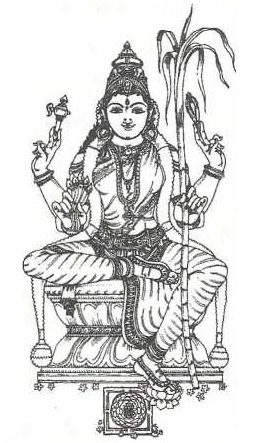Lalitā
By Swami Harshananda
Worship of Lalitā[edit]
Lalitā is an aspect of the Devī which is more widely worshiped in South India. She is famous as Lalitā Tripurasundarī. Her worship includes the following rituals:
- Repetition of the well known Lalitāsahasranāma and Triśatī.
- Worship of her emblem, the ‘Śrīcakra’. Regular worship of the Śrīcakra is said to yield any result the devotee desires.
- Initiation into her powerful mantra, the pañcadaśākṣarī (mantra of 15 letters) is an esoteric rite.
Representation of Lalitā[edit]
If Durgā and Kālī represent the power aspects of the Goddess, Lalitā represents the aspect of beauty. Hence her form is depicted as extremely beautiful. Her worship is more refined.
Goddess as per Brahmānda Purāna[edit]
According to the Lalitopākhyāna of the Brahmānda Purāna, Lalitā Devī manifested herself in the midst of a disc of extreme brilliance that arose from the sacrificial pit when Indra was performing a sacrifice in her honor. At the behest of the gods assembled there, she chose to wed Kāmeśvara.[1]
She destroyed the demon Bhaṇḍāsura and annihilated his city, the Śoṇitapura. Viśvakarmā, the engineer of the gods, built a gorgeous city named ‘Śrīpura’ on the Meru mountain for her sake. She resides there eternally along with her spouse Śiva Kāmeśvara. The Śrīcakra actually represents the Devī in Śrīpura.
Portraiture of Lalitā[edit]
Lalitā is usually depicted as slightly red in color. This is the same color as that of the dawn. She is extraordinarily beautiful. In her four hands she holds:
Sometimes she is even shown holding a wine cup made of diamond. One of her feet, usually the left, is shown resting on a pedestal made of diamond.
Symbology[edit]
Extermination of Bhaṇḍāsura[edit]
Bhaṇḍāsura was the shameless demon living in the Śoṇitapura, the city of blood and flesh. It is actually the ego which makes the soul identify itself with the body and estrange itself from all the divine forces. When the Devī, who is the embodiment of God’s power and grace, ‘kills’ it, she liberates it from its stifling limitations.
Sugarcane Bow[edit]
The bow made of sugarcane actually represents the mind. It is through the mind that we experience all joy. Hence it is described as made of sugarcane. The bow is the instrument for discharging the arrows. The mind is the instrument by which the sense organs are ‘shot’ towards the sense-objects. Hence it is described as a bow.
Arrows[edit]
The arrows are the pañca- tanmātras, the five subtle elements:
The sense organs like the eye and the ear are the products of these subtle elements. They are discharged like arrows, through the mind towards the sense-objects. Hence the subtle elements are described as the arrows in her hand. She is the power that energizes and controls our minds and sense organs. This is the underlying idea.
Noose and Goad[edit]
The pāśa (noose) is actually rāga or attachment which binds. The aṅkuśa (goad) is krodha (anger, aversion) which hurts. The power that animates our attachments and aversions is also hers. If we forget her, she can bind us with rāgapāśa and pierce us with the krodhāṅkuśa. If we take refuge in her, she can withdraw them into her hands and thereby free us from their torment.
Śrīcakra[edit]
The Srīcakra is essentially a yantra, the form and pattern of the deity. It is a rather complicated geometrical figure of forty three triangles formed by the intersection of nine triangles. Out of these nine triangles five have their apexes downward and the other four upward. This is surrounded by concentric circles with eight and then sixteen lotus petals. The whole figure is skirted by a square of three lines with openings in the middle of each side. There is a dot in the center of the entire diagram.
The Śrīcakra can be used for permanent worship either in the form of a yantra (two dimensional engraved figure) or in the form of meru (three dimensional figure).
Dot in Śrīcakra[edit]
Dot in Śrīcakra represents the combination of Śiva and Śakti as the first throb which gradually gathers momentum and gets concentrated into a polarization of Śiva and Śakti but preserving the original Śiva-Śakti combination also. The process repeats continuously resulting in various levels of creation, which are depicted by the different triangles and the lotus petals.
References[edit]
- The Concise Encyclopedia of Hinduism, Swami Harshananda, Ram Krishna Math, Bangalore

